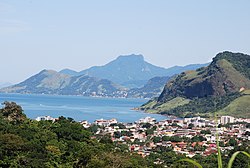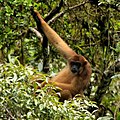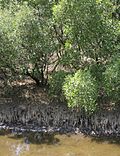Muriqui Vila Muriqui | |
|---|---|
District | |
 Panoramic view of Muriqui | |
 Location in Mangaratiba | |
| Coordinates: 22°55′33.8″S43°56′52.2″W / 22.926056°S 43.947833°W | |
| Country | |
| State | |
| Municipality/City | |
| Established | c. 1597 |
| Incorporated (district) | 1 December 1949 |
| Named after | Muriqui spider monkeys |
| Area | |
• Total | 38.0268 km2 (14.6822 sq mi) |
| [a] | |
| Elevation [2] (Posto de Saúde Muriqui) | 5 m (16 ft) |
| Highest elevation | 1,226 m (4,022 ft) |
| Lowest elevation [2] (Praia de Muriqui) | 0 m (0 ft) |
| Population (2010) [1] | |
• Total | 10,241 |
| • Density | 269.31/km2 (697.5/sq mi) |
| Demonyms | Vila-muriquiense; muriquiense |
| Sex ratio (2010) | |
| • Female | 5,225 (51.02%) |
| • Male | 5,016 (48.98%) |
| Time zone | UTC−3 (BRT) |
| Website | www |
Muriqui (also known as Vila Muriqui) is a district [4] of the municipality of Mangaratiba, located within the Greater Rio de Janeiro, Brazil. It is part of the Green Coast. Highway BR-101 passes through the district.
Contents
- Etymology
- History
- Colonial era
- Late modern period
- Population
- Administration
- Fauna and Flora
- Hydrography
- Beaches
- Rivers
- Culture
- Art
- Cuisine
- Folklore
- Sport
- Notable people
- Notes
- References
- Bibliography
- Further reading
- External links
The district has a patron saint, the Blessed Virgin Mary (Portuguese : Nossa Senhora das Graças). [5] Since the 1950s, the local parish has celebrated annually on the 27th of November, the date Catherine Labouré reportedly had a vision of her in 1830. [6]














